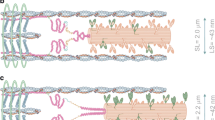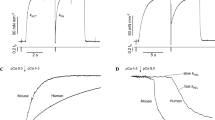Summary
To determine dynamic properties of contracting cardiac muscle, we studied the isotonic segment length changes of isolated rat right ventricular papillary muscles in response to step tension reductions during Ba2+ contracture and the chemically skinned Ca2+ -activated state, using a newly developed segment control system. The segment length responses comprised four different phases, which were consistent with those properties of heart muscle in Ba2+ contracture previously characterized using step and sinusoidal length changes [4–6, 12]. The first phase is a rapid and minute shortening during the tension reduction. The second phase is a slow further shortening, and the third a slow lengthening. The fourth is an extremely slow and mild shortening. Increasing temperature slightly decreased the amplitude and markedly shortened the duration of segment length response in the second and third phases. Unlike that of the activated muscle, the segment length responses of the resting and the rigor muscle changed in a nearly stepwise fashion. From these results, we conclude that the transient segment length response following a rapid tension reduction is mostly determined by the kinetics of the attachment and detachment of cross-bridges between actin and myosin filaments. Lastly, we discuss the length- and activation-dependence of segment length response, particularly of the velocity of segment shortening, in terms of the cross-bridge kinetics.
Access this chapter
Tax calculation will be finalised at checkout
Purchases are for personal use only
Preview
Unable to display preview. Download preview PDF.
Similar content being viewed by others
References
Steiger GJ (1971) Stretch activation and myogenic oscillation of isolated contractile structures of heart muscle. Pflugers Arch 330: 347–361
Forman R, Ford LE, Sonnenblick EH (1972) Effect of muscle length on the force-velocity relationship of tetanized cardiac muscle. Circ Res 31: 195–206
Maughan DW, Low FS, Alpart NR (1978) Isometric force development, isotonic shortening, and elasticity measurements from Ca2+-activated ventricular muscle of the guinea pig. J Gen Physiol 71: 431–451
Saeki Y, Sagawa K, Suga H (1978) Dynamic stiffness of cat heart muscle in Ba2+-induced contracture. Circ Res 42: 324–333
Saeki Y, Sagawa K, Suga H (1980) Transient tension responses of heart muscle in Ba2+ contracture to step length changes. Am J Physiol 238: H340-H347
Saeki Y, Shibata T, Yanagisawa K (1984) Isotonic length transient of cat heart muscle in Ba2+-induced contracture. Am J Physiol 247: H548-H555
Saeki Y, Kato C, Horikoshi T, Yanagisawa K (1984) Effects of Ba2+ on the mechanical properties of glycerinated heart muscle. Pflugers Arch 400: 235–240
Julian FJ, Sollins MR, Moss RL (1976) Absence of a plateau in length-tension relationship of rabbit papillary muscle when internal shortening is prevented. Nature 260: 340–342
Pollack GH, Kreuger JW (1976) Sarcomere dynamics in infarct cardiac muscle. Eur J Cardiol 4: 53–65
Donald TC, Reeves DNS, Reeves RC, Walker AA, Hefner LL (1980) Effect of damaged ends in papillary muscle preparations. Am J Physiol 238: H14-H23
Saeki Y, Totsuka T, Kato C, Yanagisawa K (1986) Length-tension relation of cat heart muscle studied by a segment-control method. Heart Vessels 2: 208–212
Shibata T, Hunter WC, Yang A, Sagawa K (1987) Dynamic stiffness measured in central segment of excised rabbit papillary muscles during barium contracture. Circ Res 60: 756–769
ter Keurs HEDJ (1983) Calcium and contractivity. In: Drake-Holland AJ, Noble MIM (eds) Cardiac metabolism. Wiley, pp 73–99
Daniels M, Noble MIM, ter Keurs HEDJ, Wohlfart B (1984) Velocity of sarcomere shortening in rat cardiac muscle: relationship to force, sarcomere length, calcium and time. J Physiol 355: 367–381
Alpert NR, Hamrell BB, Mulieri LA (1979) Heart muscle mechanics. Annu Rev Physiol 41: 521–537
Bodem R, Sonnenblick EH (1974) Deactivation of contraction by quick releases in the isolated papillary muscle of the cat. Effects of lever dam**, caffeine and tetanization. Circ Res 34: 212–225
De Clerck NM, Claes VA, Brutsaert DL (1977) Force velocity relations of single cardiac muscle cells. J Gen Physiol 69: 221–241
Jewell BR (1977) A re-examination of the influence of muscle length on myocardial performance. Circ Res 40: 221–230
Saeki Y, Totsuka T, Kato C, Yanagisawa K (1987) The influence of activation level on the tension-velocity relationship in cardiac muscle segment. Automedica 9. 131
Bozler E (1975) Mechanical control of the time-course of contraction of the frog heart. J Gen Physiol 65: 329–344
Author information
Authors and Affiliations
Editor information
Editors and Affiliations
Rights and permissions
Copyright information
© 1989 Springer-Verlag Tokyo
About this chapter
Cite this chapter
Saeki, Y., Horikoshi, T., Shiozawa, K. (1989). Isotonic Segment Dynamics of Isolated Cardiac Muscle. In: Hori, M., Suga, H., Baan, J., Yellin, E.L. (eds) Cardiac Mechanics and Function in the Normal and Diseased Heart. Springer, Tokyo. https://doi.org/10.1007/978-4-431-67957-8_4
Download citation
DOI: https://doi.org/10.1007/978-4-431-67957-8_4
Publisher Name: Springer, Tokyo
Print ISBN: 978-4-431-68020-8
Online ISBN: 978-4-431-67957-8
eBook Packages: Springer Book Archive




